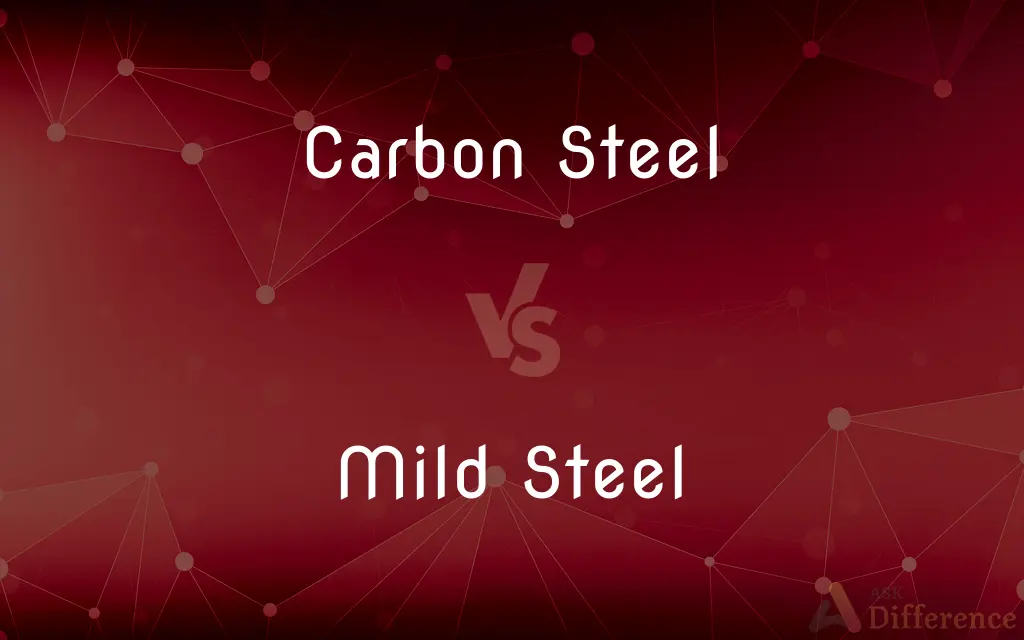Carbon Steel vs. Mild Steel — What's the Difference?
Edited by Tayyaba Rehman — By Fiza Rafique — Published on December 2, 2023
Carbon Steel is steel with carbon as its primary alloying element; Mild Steel is a type of Carbon Steel with low carbon content (0.05% to 0.25%).

Difference Between Carbon Steel and Mild Steel
Table of Contents
ADVERTISEMENT
Key Differences
Carbon Steel, as its name suggests, primarily relies on carbon as its main alloying constituent. The proportion of carbon in this type of steel can range from low to high. Depending on its carbon content, Carbon Steel can be further categorized into mild, medium, and high carbon steel. Mild Steel, on the other hand, is a subset of Carbon Steel and is characterized by its notably low carbon content, typically from 0.05% to 0.25%. Due to this low carbon concentration, Mild Steel is more ductile and malleable than higher carbon steels.
Carbon Steel's properties, such as strength, hardness, and the ability to become harder through heat treatments, are directly influenced by the amount of carbon it contains. In contrast, because of its low carbon content, Mild Steel does not respond as effectively to heat treatments, and its hardness and strength are comparatively lower than other carbon steels. However, Mild Steel is more weldable and can be shaped more easily.
Mild Steel is often used in applications where weldability is crucial, due to its excellent welding properties. This is in contrast to Carbon Steel with higher carbon content, which can become brittle and less ductile, making it more challenging to weld. Mild Steel is also more prone to corrosion compared to other types of Carbon Steel, which can be combated using protective coatings or treatments.
Carbon Steel's versatility is undeniable, with its variations serving a wide array of industries and applications. While Mild Steel, with its specific attributes, is ideal for construction projects, automobile bodies, and other scenarios where its ductility and weldability can be leveraged. Despite the differences, both Carbon Steel and Mild Steel are fundamental in the world of metallurgy, each serving unique needs based on its properties.
Comparison Chart
Carbon Content
Can range from low to high
Low (0.05% to 0.25%)
ADVERTISEMENT
Hardness and Strength
Varies based on carbon content
Relatively lower
Weldability
Decreases with increasing carbon content
Excellent weldability
Ductility
Decreases with increasing carbon content
More ductile
Response to Heat Treatment
Effective, especially for higher carbon steels
Less effective due to low carbon content
Compare with Definitions
Carbon Steel
Contains elements other than carbon but in small amounts.
Carbon Steel may have trace amounts of manganese or silicon.
Mild Steel
Carbon Steel with low carbon concentration.
Mild Steel sheets are often used in car body manufacturing.
Carbon Steel
Can be categorized based on its carbon content.
High-carbon Carbon Steel is utilized for knife blades.
Mild Steel
Less responsive to heat treatments due to low carbon content.
Mild Steel doesn't harden as effectively as high-carbon steel when heat-treated.
Carbon Steel
A material used in a variety of industries due to its versatility.
Carbon Steel is essential in the manufacturing of tools.
Mild Steel
Economical choice for large-scale projects.
Mild Steel plates are widely used in shipbuilding.
Carbon Steel
Responds to heat treatments based on carbon percentage.
Carbon Steel can be tempered to achieve desired properties.
Mild Steel
Prone to corrosion but can be protected.
Mild Steel structures might require protective coatings to prevent rust.
Carbon Steel
Steel alloyed mainly with carbon.
The hardness of Carbon Steel is determined by its carbon content.
Mild Steel
Known for excellent weldability and ductility.
Mild Steel beams are prevalent in construction projects.
Common Curiosities
Which type of steel is more ductile, Carbon Steel or Mild Steel?
Mild Steel is more ductile due to its lower carbon content.
What is the primary alloying element in Carbon Steel?
The primary alloying element in Carbon Steel is carbon.
Is Mild Steel more or less weldable than high-carbon Carbon Steel?
Mild Steel is more weldable than high-carbon Carbon Steel.
Which steel is more suitable for construction projects?
Mild Steel is often preferred due to its ductility and weldability.
How does the carbon content in Mild Steel generally range?
In Mild Steel, the carbon content typically ranges from 0.05% to 0.25%.
What is one drawback of Mild Steel?
Mild Steel is more prone to corrosion compared to some other types of Carbon Steel.
Is Carbon Steel exclusive to industries?
No, Carbon Steel, including Mild Steel, is used in various applications, from tools to construction.
Can Carbon Steel have a low carbon content similar to Mild Steel?
Yes, Carbon Steel can have low carbon content, but when it does, it's often referred to as Mild Steel.
Is Carbon Steel always harder than Mild Steel?
Not necessarily. The hardness of Carbon Steel depends on its carbon content. High-carbon steels are harder than Mild Steel, but low-carbon steels may not be.
Why is Mild Steel more prone to corrosion?
Mild Steel lacks certain elements and carbon content that can protect against corrosion.
Can Mild Steel be hardened through heat treatment?
Mild Steel can be hardened to some extent, but not as effectively as high-carbon steels.
Are there Carbon Steels with a medium range of carbon content?
Yes, apart from low and high, there's also medium-carbon Carbon Steel.
Share Your Discovery

Previous Comparison
Active Learning vs. Passive Learning
Next Comparison
Reducing Sugar vs. Nonreducing SugarAuthor Spotlight
Written by
Fiza RafiqueFiza Rafique is a skilled content writer at AskDifference.com, where she meticulously refines and enhances written pieces. Drawing from her vast editorial expertise, Fiza ensures clarity, accuracy, and precision in every article. Passionate about language, she continually seeks to elevate the quality of content for readers worldwide.
Edited by
Tayyaba RehmanTayyaba Rehman is a distinguished writer, currently serving as a primary contributor to askdifference.com. As a researcher in semantics and etymology, Tayyaba's passion for the complexity of languages and their distinctions has found a perfect home on the platform. Tayyaba delves into the intricacies of language, distinguishing between commonly confused words and phrases, thereby providing clarity for readers worldwide.














































